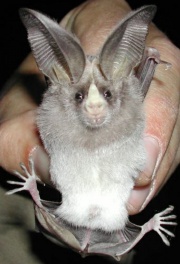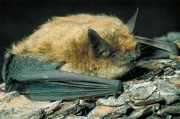Difference between revisions of "Bat"
Jump to navigation
Jump to search
| (One intermediate revision by the same user not shown) | |||
| Line 11: | Line 11: | ||
==Resources and Citations== | ==Resources and Citations== | ||
| − | * English Heritage | + | * English Heritage: [https://cofeportsmouth.contentfiles.net/media/assets/file/Bats_in_Churches_-_a_management_guide.pdf#:~:text=Churches%20play%20an%20important%20role%20in%20helping%20to,be%20sought%20through%20Natural%20England%20and%20English%20Heritage. Bats in Churches] |
* ''Encyclopedia Britannica'', https://www.britannica.com/topic/Britannica-Online, Comment: "bat." Accessed 31 Jan. 2005. | * ''Encyclopedia Britannica'', https://www.britannica.com/topic/Britannica-Online, Comment: "bat." Accessed 31 Jan. 2005. | ||
Latest revision as of 11:42, 2 May 2022
Description
Any small flying mammal of the order Chiroptera. Bats are found throughout the temperate and tropical regions of the world. Their acoustical system allows them to accurately locate items by emitting a sound and evaluating its echo (echolocation). Bats primarily feed on insects but may also eat fruits and pollen. Bats often live in historic sites and public buildings, such as churches, where they can be a nuisance due to their noise, droppings (Guano), and odor.
Synonyms and Related Terms
bats; Chiroptera; flagermus (Dan.); Fledertiere (Deut.); murciélagos(Esp.); chiroptère (Fr.); pipistrello (It.); vleermuizen (Ned.; nietoperze (Pol.); morcego (Port.)
Resources and Citations
- English Heritage: Bats in Churches
- Encyclopedia Britannica, https://www.britannica.com/topic/Britannica-Online, Comment: "bat." Accessed 31 Jan. 2005.
- Wikipedia: http://en.wikipedia.org/wiki/Bat (Accessed Oct. 8, 2005)


